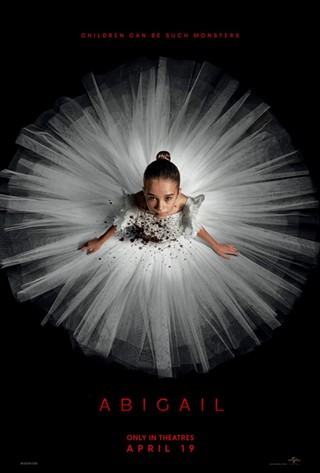This creates, in Standard Operating Procedure, one of the most inappropriate meldings of style and content I've ever seen. S.O.P. is about the abuse of prisoners at Abu Ghraib. It's not a pretty subject. It's not a subject that should be prettied up. And yet Morris can't help himself: He slathers lipstick all over this pig. The result is morally reprehensible and aesthetically disgusting--but the worst thing about this travesty is how completely lazy it is.
First of all, Morris is not an investigative documentarian; he generally just interviews people. And the people he interviews in Standard Operating Procedure are mostly the low-level grunts who appeared in the infamous Abu Ghraib photographs. So if you want to catch up on what Lynndie England is doing these days, and you want to see how Sabrina Harmon and Megan Ambuhl are holding up, well, this will be like a good-time family reunion for you.
Morris does interview them, sort of, but for the most part, he just gives them a chance to make excuses. Harmon, for example, claims she was only documenting what was happening because she wanted people to know what the Army was up to. This may well be true, but without any context, or any challenge to her claims, it's hard to say. England at least admits she did some of the stuff she was photographed doing, but she has some pretty roundabout explanations for some of the pictures. Like that guy on the dog leash? She wasn't dragging him; he just felt like crawling out of his cell.
Mostly, though, what everyone does is blame someone else. That makes some sense: These are all enlisted people, and it's likely that they didn't do, and couldn't have done, all of this stuff without some supervision. In fact, we now know that the torture techniques employed at Abu Ghraib were the same as those approved by Cheney, Rumsfeld, Rice, Powell, Tenet, Ashcroft and others in the Bush administration (including, shockingly, that nice man who gave the Bush administration its name). But what's lacking in Morris' documentary is any sense of this connection. The interviewees frequently cite some mysterious "they" who told them what to do, but Morris does no work to uncover who this "they" is.
Obviously, the upper-level "they" is now known to us. If Morris had simply done a little legwork, asked a few tough questions and gathered a few documents, he could have shown who the midlevel "they" was. But he does nothing of the sort: He just lets his interviewees prattle on about following orders and doing what they were told to do--which is certainly chilling, and no doubt important, but it's not nearly enough to make a documentary. Without the investigatory part of the work, Morris fills things out with re-enactments of some of the more egregious events at the prison. And this is where the film really falls on its face.
His re-enactments are gorgeous: Super-slow-motion shots show water coming out of a faucet. A cell is painted in glorious reds to indicate blood-spatter. The camera lovingly pans along a naked man's side, his perfectly lit skin glowing and smooth. Meanwhile, Philip Glass-esque music (strangely enough, composed by Danny Elfman in a massive departure from his usual style) offers its repetitive, haunting and beautiful violin riffs in the background.
In short, what the hell was Morris thinking? I guess if you don't know the most basic facts about Abu Ghraib, the stuff that was reported in every newspaper in the world, and you want it explained to you very, very slowly while pretty music plays in the background, then Standard Operating Procedure could be worth seeing. And if Morris was interested only in letting the participants tell their stories and in creating some sympathy for them, then I guess he succeeded, but that's not exactly a laudable goal.
The problem is that there are some real hints offered by the interviewees about where the orders were coming from, but these few, tantalizing bits are just left hanging so that Morris can get another shot of light shining off a pool of blood.
I would strongly recommend that everyone on Earth watch Taxi to the Dark Side, which, though it lacks Morris' slick styling and huge budget, is nonetheless the superior film on our government's recent turn toward rogue status. Filmmaker Alex Gibney not only interviewed Army personnel who'd been convicted of abusing prisoners; he also followed up and connected the dots. With information now available, Gibney's film's speculations have been fully confirmed.
Morris had an opportunity to work with that new information. Instead, he decided to make Gone With the Wind in an Iraqi prison. For that, he deserves none of the accolades that Gibney received.










